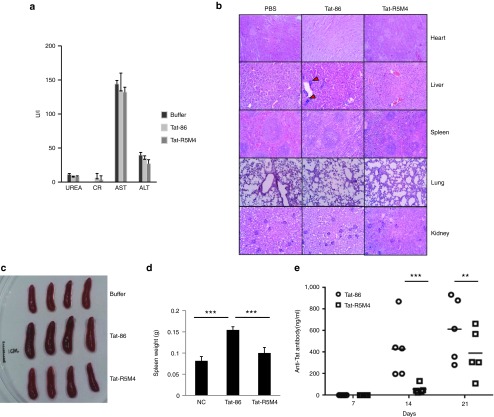Figure 5.
Analysis of acute toxicity and immunogenicity for Tat-R5M4. (a) The female Balb/c mice weighing 19 ± 1 g were intravenously injected with Tat-R5M4 at 40 mg/kg. The blood samples were collected at day 7 and subjected to the detections of blood glutamate-oxaloacetate transaminase (ALT), glutamate-pyruvate transaminase (AST), blood urea nitrogen (UREA), creatine (CR). (b) Mice were sacrificed after 7 days; their multiple organs were fixed in 4% formaldehyde for hematoxylin and eosin staining. The red triangles indicate the inflammatory cell infiltration. (c) After intravenous injection of proteins, the sizes of spleens from each group were measured, and (d) the weight changes induced by Tat-86 and Tat-R5M4 were measured and the mean ± SEM of three independent experiments are shown in panels b–e, The unpaired t-tests were used. **P < 0.01, ***P < 0.001. (e) The concentrations of anti-Tat antibodies induced by Tat-86 and Tat-R5M4. The 4-week-old female BABL/c mice were immunized subcutaneously with 1 μg Tat-86 or Tat-R5M4 protein (n = 5 per group) in combination with the complete Freund's adjuvant (Sigma) on day 0, and boosted three times with antigens in combination with the incomplete Freund's adjuvant (IFA) (Sigma). The concentration of anti-Tat antibody was detected by double-antibody sandwich enzyme-linked immunosorbent assay. Two-way analysis of variance was used for data analysis, **P < 0.01, ***P < 0.001.

